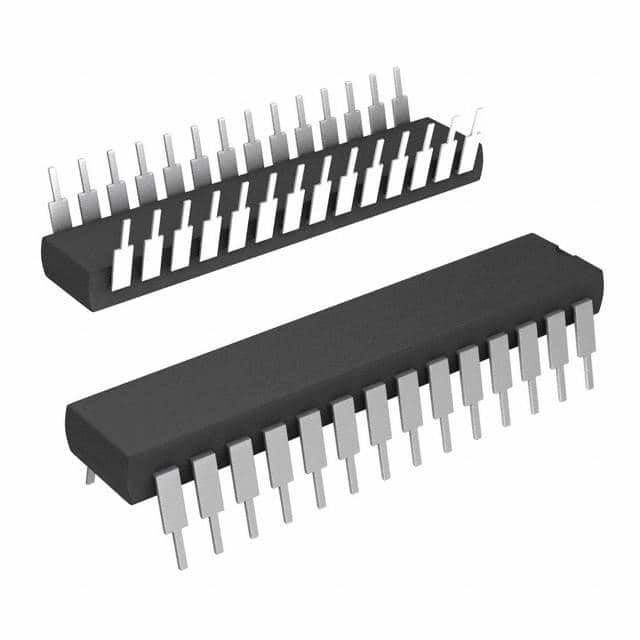AT90S2333-8PC
Product Overview
Category
AT90S2333-8PC belongs to the category of microcontrollers.
Use
This microcontroller is commonly used in various electronic applications that require embedded control and processing capabilities.
Characteristics
- Low-power consumption
- High-performance RISC architecture
- In-system programmable flash memory
- EEPROM data memory
- Peripheral features for general-purpose applications
- 8-bit AVR microcontroller
Package
AT90S2333-8PC is available in a PDIP (Plastic Dual Inline Package) format.
Essence
The essence of AT90S2333-8PC lies in its ability to provide efficient and reliable control and processing capabilities in a compact form factor.
Packaging/Quantity
AT90S2333-8PC is typically packaged in tubes or trays, with quantities varying based on customer requirements.
Specifications
- Operating Voltage: 2.7V - 5.5V
- Flash Memory: 2KB
- EEPROM Memory: 128 bytes
- SRAM Memory: 128 bytes
- Clock Speed: 8 MHz
- Digital I/O Pins: 18
- Analog Input Pins: 8
- Timers/Counters: 2
- Communication Interfaces: SPI, USART
Detailed Pin Configuration
The AT90S2333-8PC microcontroller has a total of 20 pins, which are assigned specific functions for input/output, communication, and power supply. The detailed pin configuration is as follows:
- RESET: Reset pin for initializing the microcontroller.
- VCC: Power supply voltage input.
- GND: Ground reference.
- XTAL1: Crystal oscillator input.
- XTAL2: Crystal oscillator output.
- PORTB0: General-purpose I/O pin.
- PORTB1: General-purpose I/O pin.
- PORTB2: General-purpose I/O pin.
- PORTB3: General-purpose I/O pin.
- PORTB4: General-purpose I/O pin.
- PORTB5: General-purpose I/O pin.
- PORTB6: General-purpose I/O pin.
- PORTB7: General-purpose I/O pin.
- ADC0: Analog input channel 0.
- ADC1: Analog input channel 1.
- ADC2: Analog input channel 2.
- ADC3: Analog input channel 3.
- ADC4: Analog input channel 4.
- ADC5: Analog input channel 5.
- AVCC: Analog power supply voltage input.
Functional Features
- High-performance RISC architecture allows for efficient execution of instructions.
- In-system programmable flash memory enables easy firmware updates.
- EEPROM data memory provides non-volatile storage for critical data.
- Peripheral features such as timers/counters and communication interfaces enhance the microcontroller's capabilities.
- Low-power consumption makes it suitable for battery-powered applications.
Advantages and Disadvantages
Advantages
- Compact size and low-power consumption make it ideal for portable devices.
- In-system programmability allows for easy firmware updates.
- High-performance RISC architecture ensures efficient execution of instructions.
Disadvantages
- Limited memory capacity compared to higher-end microcontrollers.
- Lack of advanced features found in more specialized microcontrollers.
Working Principles
AT90S2333-8PC operates based on the principles of a typical microcontroller. It executes instructions stored in its flash memory, interacts with external devices through its I/O pins, and utilizes its peripheral features to perform various tasks. The clock speed determines the rate at which instructions are executed, while the power supply voltage provides the necessary energy for operation.
Detailed Application Field Plans
AT90S2333-8PC finds applications in various fields, including but not limited to: - Home automation systems - Industrial control systems - Consumer electronics - Automotive electronics - Medical devices
Detailed and Complete Alternative Models
Some alternative models that offer similar functionality to AT90S2333-8PC include: - ATmega328P - PIC16F877A - STM32F103C8T6 - MSP430G2553
These alternative models provide comparable features and capabilities, allowing developers to choose the most suitable microcontroller for their specific application requirements.
In conclusion, AT90S2333-8PC is a versatile microcontroller with low-power consumption, high-performance RISC architecture, and in-system programmable flash memory. It finds applications in various fields and offers advantages such as compact size and easy firmware updates. However, it has limitations in terms of memory capacity and advanced features compared to more specialized microcontrollers. Developers can consider alternative models with similar functionality based on their specific application needs.
Lista 10 Vanliga frågor och svar relaterade till tillämpningen av AT90S2333-8PC i tekniska lösningar
Sure! Here are 10 common questions and answers related to the application of AT90S2333-8PC in technical solutions:
Q: What is the AT90S2333-8PC microcontroller used for? A: The AT90S2333-8PC is a microcontroller commonly used for various technical solutions, such as embedded systems, robotics, automation, and control applications.
Q: What is the operating voltage range of the AT90S2333-8PC? A: The AT90S2333-8PC operates within a voltage range of 2.7V to 5.5V.
Q: How much flash memory does the AT90S2333-8PC have? A: The AT90S2333-8PC has 2KB (2048 bytes) of flash memory for program storage.
Q: Can I use the AT90S2333-8PC for analog signal processing? A: No, the AT90S2333-8PC does not have built-in analog-to-digital converters (ADCs), so it is not suitable for direct analog signal processing.
Q: What communication interfaces are available on the AT90S2333-8PC? A: The AT90S2333-8PC supports serial communication through its USART (Universal Synchronous/Asynchronous Receiver/Transmitter) interface.
Q: How many I/O pins does the AT90S2333-8PC have? A: The AT90S2333-8PC has a total of 18 I/O pins, which can be configured as inputs or outputs.
Q: Can I use the AT90S2333-8PC with Arduino? A: Yes, the AT90S2333-8PC can be programmed using the Arduino IDE and can be used in Arduino projects with some modifications.
Q: What is the maximum clock frequency of the AT90S2333-8PC? A: The AT90S2333-8PC can operate at a maximum clock frequency of 8 MHz.
Q: Does the AT90S2333-8PC have any built-in timers? A: Yes, the AT90S2333-8PC has two 8-bit timers/counters and one 16-bit timer/counter for various timing and counting applications.
Q: Can I use the AT90S2333-8PC in battery-powered applications? A: Yes, the low operating voltage range and low power consumption make the AT90S2333-8PC suitable for battery-powered applications.
Please note that these answers are general and may vary depending on specific application requirements and programming techniques.


